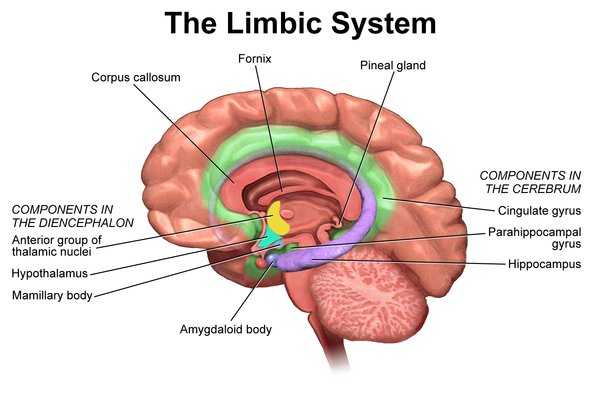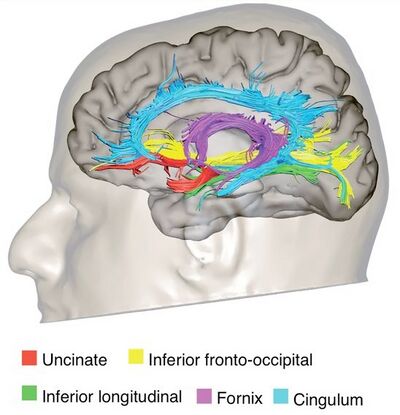Limbic System
Original Editor - Lucinda hampton
Top Contributors - Lucinda hampton, Jess Bell, Stacy Schiurring, Kim Jackson and Rucha Gadgil
Introduction to the Limbic System[edit | edit source]
The limbic system is involved in essential survival behaviours, such as feeding, reproduction, caring for offspring and our fight or flight response.[1]
It is a complex network of brain of structures that are located lateral to the thalamus, beneath the cerebral cortex and above the brainstem.[2] The limbic system supports various functions, including (1) emotion, (2) behaviour, (3) motivation, (4) long-term memory, (5) olfaction and (6) stress response.[3]
In evolutionary terms, it is one of the oldest parts of the brain and it "constitutes a functional concept, and is characterized by dense afferent projections from brainstem and forebrain nuclei, which contributes to behavioral modulation"[4]
Important Limbic Structures[edit | edit source]
There is still no consensus on all the structures that make up the limbic system,[4] but key structures include the amygdala, hippocampus, thalamus, hypothalamus, basal ganglia, and cingulate gyrus[2]
Amygdala[edit | edit source]
The amygdala is a small almond-shaped structure located in each temporal lobe, just below the uncus.[5] We have two amygdalae, one in each hemisphere of the brain:
- the amygdalae play an imprtant role in processing information between the prefrontal-temporal association cortices and the hypothalamus[5]
- they are involved in regulating anxiety, aggression, fear conditioning, emotional memory and social cognition, behavioural and physiological stress responses[5]
Hippocampus[edit | edit source]
The hippocampus is a paired structure[6] located in the parahippocampal gyrus, near the inferior temporal horn of the lateral ventricle.[7] It has three regions: (1) dentate gyrus, (2) hippocampus proper, (3) subiculum:[7]
- the hippocampus plays an essential role in forming new memories, particularly consolidated short- and long-term memories, spatial navigation, regulating emotions, motivation, hormones and autonomic activity[6][7][8]
- with the prefrontal cortex, the hippocampus is involved in episodic memory[9]
Thalamus and Hypothalamus[edit | edit source]
The thalamus functions as a relay station between the brain and the body, filtering through various types of sensory and motor information.
The hypothalamus plays a major role in maintaining homeostasis via the autonomic nervous system, the neuroendocrine system, and the limbic system.
If you would like to learn more about these structures, please see:
Cingulate Gyrus[edit | edit source]
The cingulate gyrus is a paired structure that is located on the medial surface of each cerebral hemisphere, wrapping around the corpus callosum.[10] It has four regions (1) anterior cingulate cortex (ACC) (2) midcingulate cortex, (3) posterior cingulate cortex (PCC) and (4) retrosplenial cortex.[10]
Key functions include:[10]
- processing emotions and regulating emotional responses
- cognitive processing (particularly reward-based decision-making)
- processing information from internal and external states to help guide motor responses
- imagination
- episodic memory formation and consolitation
The cingulate cortex can be described as "a connecting hub of emotions, sensations, and action."[10]
Basal Ganglia[edit | edit source]
The basal ganglia are a group of subcortical nuclei[11] that are involved in motor control and learning, executive functions, emotional behaviours, reward and reinforcement, addictive behaviours and habit formation.[12]
For more informatin, please see Basal Ganglia.
References[edit | edit source]
- ↑ Queensland Brain Institute. The limbic system. Available from: https://qbi.uq.edu.au/brain/brain-anatomy/limbic-system (last accessed 30 June 2024).
- ↑ 2.0 2.1 Torrico TJ, Abdijadid S. Neuroanatomy, Limbic System. [Updated 2023 Jul 17]. In: StatPearls [Internet]. Treasure Island (FL): StatPearls Publishing; 2024 Jan-. Available from: https://www.ncbi.nlm.nih.gov/books/NBK538491/
- ↑ Martin JH. The limbic system and cerebral circuits for reward, emotions, and memory. In: Neuroanatomy: Text and Atlas. 5th ed. McGraw Hill, 2021.
- ↑ 4.0 4.1 Banwinkler M, Theis H, Prange S, van Eimeren T. Imaging the limbic system in Parkinson's disease-a review of limbic pathology and clinical symptoms. Brain Sci. 2022 Sep 15;12(9):1248.
- ↑ 5.0 5.1 5.2 AbuHasan Q, Reddy V, Siddiqui W. Neuroanatomy, Amygdala. [Updated 2023 Jul 17]. In: StatPearls [Internet]. Treasure Island (FL): StatPearls Publishing; 2024 Jan-. Available from: https://www.ncbi.nlm.nih.gov/books/NBK537102/
- ↑ 6.0 6.1 Kenhub. Hippocampus: Anatomy and functions. Available from: https://www.kenhub.com/en/library/anatomy/hippocampus-structure-and-functions (last accessed 30 June 2024).
- ↑ 7.0 7.1 7.2 Fogwe LA, Reddy V, Mesfin FB. Neuroanatomy, Hippocampus. [Updated 2023 Jul 20]. In: StatPearls [Internet]. Treasure Island (FL): StatPearls Publishing; 2024 Jan-. Available from: https://www.ncbi.nlm.nih.gov/books/NBK482171/
- ↑ Moini J, Logalbo A, Schnellmann JG. Review of the central nervous system. In: Moini J, Logalbo A, Schnellmann JG, editors. Neuropsychopharmacology, Academic Press, 2023. p153-79.
- ↑ Eichenbaum H. Prefrontal-hippocampal interactions in episodic memory. Nat Rev Neurosci. 2017 Sep;18(9):547-58.
- ↑ 10.0 10.1 10.2 10.3 Jumah FR, Dossani RH. Neuroanatomy, Cingulate Cortex. [Updated 2022 Dec 6]. In: StatPearls [Internet]. Treasure Island (FL): StatPearls Publishing; 2024 Jan-. Available from: https://www.ncbi.nlm.nih.gov/books/NBK537077/
- ↑ Yanagisawa N. Functions and dysfunctions of the basal ganglia in humans. Proc Jpn Acad Ser B Phys Biol Sci. 2018;94(7):275-304.
- ↑ Lanciego JL, Luquin N, Obeso JA. Functional neuroanatomy of the basal ganglia. Cold Spring Harbor perspectives in medicine. 2012 Dec 1;2(12):a009621.








